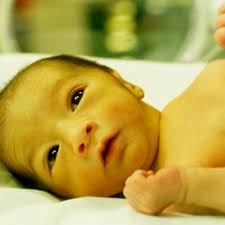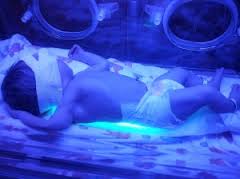What to do when newborn baby has swollen breasts?
December 18, 2014 by admin
Filed under Baby Problems
 A swollen breast is a common condition observed in babies, both male and female. Commonly seen that one or both the breast are swollen, firm and lumpy after a week of birth. Although this condition may seem abnormal, the swollen breasts usually shrink within a few weeks or months of life. The new parents will be worried at the sight of swollen breasts.
A swollen breast is a common condition observed in babies, both male and female. Commonly seen that one or both the breast are swollen, firm and lumpy after a week of birth. Although this condition may seem abnormal, the swollen breasts usually shrink within a few weeks or months of life. The new parents will be worried at the sight of swollen breasts.
Causes of a swollen breast in a newborn baby
Mother’s hormones
Swelling of breast happens because of the hormones the baby receives from the mother during pregnancy. While the baby is in the womb, the baby is exposed to variations of hormones that a mother produces during pregnancy. These hormones are passed along to the baby and remain within the baby after birth. These changes are triggered by hormones that travel throughout her bloodstream, through the placenta and to the baby via the umbilical cord.
After delivery when there is no more exposure to the hormones, the breast tissue will begin to shrink and become flat. This may take days and weeks. A milky substance called “witches milk” may leak from the nipples but will cease after a few days or weeks.
Breast feeding
Breast feeding also contribute to the baby’s breasts swelling due to the continuation of the mother’s hormones passing to the baby. While breast feeding may also contribute to prolonged breast enlargement and baby milk production, temporary or permanent weaning is not recommended.
Also read: 8 Top Tips to Keep your Newborn Baby Clean and Healthy
Breast buds
Swollen breasts in babies can contribute due to breast buds or lumps under the nipples. These lumps are mature breast tissue that can even secrete milk. Breast buds can occur in both male and female babies and will diminish over the first few months of life.
Infection
If the breast or nipple looks red, tender or has a colored discharge other than a milky substance and the baby has a fever, a pediatrician should examine the baby for infection. Be alert and observe any redness and pain for the baby.
Parents are advised not to squeeze or massage the swollen breasts, for this will only cause irritation and may lead to an infection. Swollen breasts in newborn babies is not a problem and will become less noticeable as your baby changes and grows.
Also read: Can I Continue to Breastfeed my Baby when I’m Back from Work?
Cultural differences
In India, the new mom is advised to squeeze or press the nipple during massage to remove the milk that is accumulated. General understanding by daimas is that if the milk is not removed, it will lead to larger breast and chest which can be a bother to your personality as you grow up and are in your teens. Usually observed in stout boys.
Elders in the family also insists to continue removing the milk for a week’s time. It will be done gently to ensure baby does not have pain.
However Pediatricians insist that the baby’s breast are not pressed, leave them alone and allow nature take its course in shrinking them.
Please add a comment and, if you like the post, feel free to share it with your friends. You can also visit our Facebook page and Google plus page for more insight.
What are the Symptoms of Jaundice in Newborn Baby?
December 11, 2014 by admin
Filed under Baby Problems
 Most babies are sent home after 1 or 2 days of birth, parents will have to watch their new born baby for any signs of jaundice.
Most babies are sent home after 1 or 2 days of birth, parents will have to watch their new born baby for any signs of jaundice.
Symptoms of jaundice:
Jaundice first appears on the babies face and head. As the level of bilirubin increases in the blood, the body will start showing on the body and further high levels are indicated by coloration on the palms of the hand and soles of the feet.
Testing for jaundice
Simple test that can be done at home is to press your finger tip on the tip of your child’s nose or forehead. After you lift your finger if you observe the skin is white there is no jaundice. But if you see yellowish color, consult your doctor immediately.
Blood test for jaundice
Blood test is recommended to identify the level of bilirubin and the treatment to be followed thereafter based on the blood test results and the baby’s health condition.
Serum Bilirubin values
Since 97% of term babies have serum bilirubin values <13 mg/dl, all infants with a serum bilirubin level >13 mg/dl require a minimum work up.
Causes of jaundice
Excess bilirubin (hyperbilirubinemia) is the main cause of jaundice. Bilirubin is responsible for the yellow color of jaundice, it is a normal part of the pigment released from the breakdown of “used” red blood cells.
Normally, the liver filters bilirubin from the bloodstream and releases it into the intestinal tract. A newborn’s immature liver often can’t remove bilirubin quickly enough, causing an excess of bilirubin. Jaundice due to these normal newborn conditions is called physiologic jaundice, and it typically appears on the second or third day of life.
Treatment for jaundice
Most babies who are well and healthy need not undergo treatment. As the liver matures, it will break the bilirubin into other chemicals which can be passed out through the gut.
 However Phototherapy (or light therapy) is recommended for babies whose level is getting higher. Light energy helps change the bilirubin that is just under the skin into a different chemical which is more easily passed out of the baby’s body (excreted). Babies may need phototherapy mandatorily for 48 hrs with breastfeeding the baby every 2 hrs to remove excess bilirubin from the body thru’ urine or stool. Phototherapy is safe and effective. The process followed is:
However Phototherapy (or light therapy) is recommended for babies whose level is getting higher. Light energy helps change the bilirubin that is just under the skin into a different chemical which is more easily passed out of the baby’s body (excreted). Babies may need phototherapy mandatorily for 48 hrs with breastfeeding the baby every 2 hrs to remove excess bilirubin from the body thru’ urine or stool. Phototherapy is safe and effective. The process followed is:
- Babies will be placed in a warm covered cot. They may be able to stay in their mother’s room or they may need to be moved to the ward nursery.
- They will have eye shields placed over their eyes.
- They will be nursed naked so that the maximum amount of light can fall on their skin.
- More number of feeds while the baby is having phototherapy.
- You will be encouraged to continue to care for your baby as much as possible.
- Blood tests are usually done daily to work out if your baby still needs phototherapy.
Examination for jaundice
Your baby should be examined for jaundice between the third and seventh day after birth, when bilirubin levels usually show peaks. If your baby is discharged earlier than 72 hours following birth, make a follow-up appointment to look for jaundice within two days of discharge.
Consult a doctor when you see the following symptoms:
- Your baby’s skin becomes more yellow
- Your baby’s skin looks yellow on the abdomen, arms or legs
- The whites of your baby’s eyes look yellow
- Your baby looks less energetic or sick or is difficult to awaken
- Your baby makes high-pitched cries
- Your baby isn’t gaining weight or is feeding poorly
- Your baby develops any other signs or symptoms that concern you
Jaundice lasts more than three weeks. After you complete phototherapy you can continue sunlight therapy. Take the baby to indirect sunlight early in the morning. The sun rays is also good to reduce the color for the baby.
Parents should not panic. Be alert and identify symptoms at the early stage. Do follow-up visits to the hospital after birth for routine checks.
Happy parenting!
Please add a comment and, if you like the post, feel free to share it with your friends. You can also visit our Facebook page and Google plus page for more insight.
Also read:
How to Treat Jaundice in New Born Baby
What to feed when my child has watery motions – Diarrhea
Umbilical cord care: Basics for a New mom
Vaccines for your baby – Immunization schedule
What are the Soft Spots on my Newborn Baby’s head?









